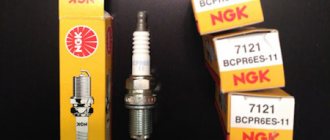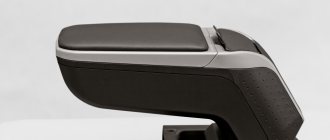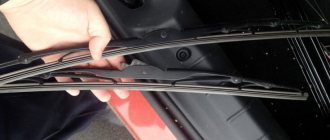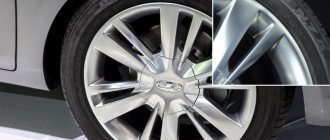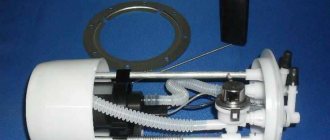Fuel filter Lada Vesta
Fuel module 21800113900900
The same fuel module is installed on Lada Vesta with 1.6 and 1.8 liter engines (no. 21800113900900 ). This is the first car produced by AvtoVAZ that does not have a separate fuel filter installed. The main feature of the Vesta fuel system is that the fine and coarse fuel filters are placed together with the pump in a separate fuel module. In its design, it is similar to the fuel system of the Renault Logan 2009 and the Lada Largus car, but still differs in the modules themselves. The electric fuel pump module is also found under the number 8450008680 . The manufacturer of the spare part is the Russian company Motorika LLC. Average price – 5000 rub. The Lada Vesta fuel module is a submersible turbine-type structure. It supplies fuel under pressure through pipes to the injector ramp. Depending on the operating mode of the engine, the regulator maintains the operating pressure in the range from 3.7 to 4 bar . The fuel level sensor is also integrated with the fuel module.
According to reviews from Lada Vesta buyers, the main disadvantage of the fuel module is the inability to change the fine filter separately from the entire unit.
If a replacement is needed, then you need to buy the fuel module assembly. You can only partially disassemble the module, during which the fuel pump, filter mesh and pressure regulator are removed. Otherwise, no major shortcomings have been found so far.
Problem
This unit has an impressive service life - up to 200,000 km. However, there are cases when it failed noticeably earlier. The reasons may be different - low-quality fuel, driving with an almost empty tank, during which the wear of the element is much more intense, which is especially true for those who have installed gas equipment in their car, and others.
The fact is that in the event of a breakdown, dealers advise replacing not only the Lada Vesta fuel pump, but the entire fuel module assembly, which also includes a strainer, a fuel level sensor and a pressure regulator.
Worn Vesta fuel pump
Technical characteristics of the Lada Vesta fuel module
The filter is a mesh (coarse), unlike the fine filter, it can be removed and cleaned with special liquids. Carb Cleaner works well . According to reviews from Vesta owners, washing is quite enough. Replacement of the mesh is not necessary. This practice is useful for extending the life of the fuel module.
According to the Lada Vesta maintenance regulations, the fuel filter is designed for the entire service life . It is changed only if the fuel pump fails (claimed service life is 180 thousand km), or large particles of debris and dust get into the tank, which eventually clog the filter element. You can extend the life of the fuel filter by using high-quality fuel at proven gas stations. The main signs of a clogged fuel filter are the same as on most cars - excessive fuel consumption and loss of power.
To access the fuel filter, you need to fold down the rear seat. Below it is the fuel module hatch. There are more than a few bolts to secure it.
At the moment, there is no official and verified information about analogues of the assembled fuel module for the Lada Vesta. The manufacturer installs a fuel pump in the fuel module under catalog number 81B04480 . , Japan. The price for the part is from RUB 3,000. At the moment, finding an original fuel pump is a little difficult. Therefore, you can use one of its analogues:
- 311111R000 - Average price - 4000 rubles. original fuel pump from Kia Rio and Hyundai Solaris cars;
- 311111G500 — Price — 5400 rub. Standard fuel pump from Korean cars Kia Picanto, Hyundai Elantra, Sonata. The part is 2 cm longer than the original.
Original fuel pump 81B04480
Fuel pump 311111R000
Fuel pump 311111G500
To install analogues, you need to slightly file the seat of the plastic housing of the fuel module, by 1-2 mm, and replace the connector. The main criterion for choosing a replacement for the original fuel pump is the operating pressure (3.7 - 4 bar).
Replacing fuses on Lada Vesta
- We place the Lada Vesta on the platform, block the rear row of wheels with wheel chocks, open the driver's door;
- To the left of the steering column, at the bottom, unsnap three plastic latches;
- Remove the cover under which the mounting block is located;
- Using plastic tweezers, remove the modules one by one and check the integrity of the melting plate. This method is applicable only when we do not know exactly the serial number of the faulty fuse.
To speed up the process of identifying a faulty element, serial numbers, module markings, and also pinouts are indicated on the back of the cover.
We replace fuses in the engine compartment by analogy:
- To disassemble the power supply housing: open the hood; on the left side, behind the battery, there is a mounting block;
- We unclip the plastic cover, remove the faulty module with tweezers, and insert a new one;
- We check the relay - switch for serviceability. We install a new one as needed.
The average service life of domestically produced fuses is 45 thousand km. Foreign analogues last longer by 10 - 15 thousand km.
If difficulties arise with installing the mounting block or replacing fuses, contact a service station specialist.
Messages 17
1 Topic by Axel 2016-01-06 09:26:46
- Axel
- Participant
- Inactive
- Messages: 973
- Thank you: 139
Topic: Fuel filter
As far as I understand, it is not possible to change it separately; it is combined with the fuel pump. It will be a bit expensive.
2 Reply from Fan 2016-01-06 15:36:41
- Fan
- Moderator
- Inactive
- From: Smolensk region
- Messages: 1,017
- Thank you: 204
Re: Fuel filter
And why this nonsense stuffing without photos and links? This is not how topics are created on normal forums.
3 Reply from Abrams 2016-01-06 15:46:14
- Abrams
- Participant
- Inactive
- Messages: 598
- Thank you: 120
Re: Fuel filter
Are the pump and filter from Renault?
4 Reply from Fan 2016-01-06 17:31:40
- Fan
- Moderator
- Inactive
- From: Smolensk region
- Messages: 1,017
- Thank you: 204
Re: Fuel filter
I don’t know why the fuel pump is there, but on Vesta now, like in many foreign cars, a fine filter is built into the fuel pump, but it is REPLACEABLE. The procedure for replacing it will now become somewhat more difficult; you will have to remove the fuel pump from the tank, but this will not have to be done every 10 thousand. According to the regulations, it seems 100 thousand, but here people usually change more often. On Grant I changed it to 40, cut it later, examined it - everything was clean.
5 Reply from Fan 2016-01-06 17:50:45
- Fan
- Moderator
- Inactive
- From: Smolensk region
- Messages: 1,017
- Thank you: 204
Re: Fuel filter
6 Reply from Axel 2016-01-06 19:23:00
- Axel
- Participant
- Inactive
- Messages: 973
- Thank you: 139
Re: Fuel filter
But replacement is still quite problematic and time-consuming. They could have done it simpler, especially with our fuel quality.
Fuel filter location
A feature of the fuel system of such models as Lada Vesta and Xray, the price of which is exceptionally attractive, is its built-in design. What does it mean? First of all, the coarse and fine fuel filters in these models are built into their electric fuel pumps.
Moreover, these models have different types of electric pumps. If in the case of the Xray model they use a device identical to the one that can be found not only in Lada Largus, Granta or Kalina, but also in Renault Logan and Sandero, then the situation with Vesta is different.
The latest model has a different fuel pump. Its catalog number is 21800113900900. This, however, does not lead to a big difference in technical characteristics.
How often should the fuel filter be changed?
A car consumes countless amounts of fuel over its life. If we take the average fuel consumption as 10 liters per hundred kilometers, then during the warranty period alone, which is equal to 100,000 km for most manufacturers, approximately 10,000 liters of fuel will pass through the car’s fuel system. Now let’s imagine how much dirt such an amount of fuel can bring into the power system.
The frequency of routine filter replacement is primarily determined by the vehicle manufacturer. For some manufacturers this is 30,000 km, for others - 120,000 km. Moreover, frequent replacements are usually recommended by manufacturers who place the filter outside the fuel tank.
Diesel engine fuel filters have the most difficult time in winter: after all, thickened fuel must pass through the filter material. That is why it is better to carry out preventive filter replacement on a diesel car in the fall. This is due to the fact that the filter capacity, already reduced by clogging with solid particles, will be insufficient to pass the cold, thickened fuel.
Frequency of replacement of gasoline filters of some manufacturers, thousand km:
- Volkswagen 30 (remote filters)
- Renault 120
- Kia 60
- Hyundai 60
- Lada 30 (remote filters), 120 (built-in filters)
Some tips for replacing the fuel filter:
- Refuel at proven, or even better, branded gas stations.
- Try not to pour fuel into the tank immediately after the fuel has been drained from the tanker at a gas station, because the fuel in the tank is agitated and dirt is more likely to get in.
- Do not pour fuel into old, rusty cans.
- Change fuel filters on time - then a malfunction will not catch you on a long journey.
- Wash the fuel intake strainer at the pump inlet: this will extend its service life.
Tell us in the comments if you have encountered problems related to fuel filters? Good luck on the roads everyone!
Lada Xray. Replacing the fuel filter
In accordance with the maintenance regulations, we replace the fuel filter every 30 thousand km.
If the car is operated in dusty conditions or with low fuel quality, the filter must be replaced more often than specified in the regulations. We carry out the work on an inspection ditch or overpass.
The fuel filter is installed at the bottom of the vehicle in a recess in the underbody above the additional muffler for the exhaust system.
The fuel in the power system (with the ignition on and for some time after it is turned off) is under pressure. Therefore, if we replace the filter immediately after a trip or after turning on the ignition, it is necessary to relieve the fuel pressure in the power system. If the ignition has not been turned on for a day or more, there is usually no fuel pressure in the system. This can be checked by unscrewing the cap of the fuel rail fitting and pressing the spool rod (see “Power system”, page 123).
When replacing the filter, you need to take into account that it is located below the fuel tank and when the filter is removed, fuel can flow out of the tank by gravity through the disconnected tube. Therefore, we place a container under the filter to collect fuel.
To relieve pressure in the system, remove the lining of the left front side panel (see “Removing the controller,” p. 115).
By pressing the two latches, we disconnect the connection block between the engine management system wiring harness and the rear wiring harness.
We start the engine and let it idle until it stops due to fuel exhaustion. Then turn on the starter for 2-3 seconds. After this, the pressure in the power system will be released.
Using a 10mm wrench, loosen the tightening of the fuel filter clamp bolt.
Holding the fuel filter housing by the hexagon with a 19mm wrench, use a 17mm wrench to unscrew the fitting of the fuel supply tube to the filter.
We remove the tip of the tube from the filter and, in order to avoid fuel leakage from the tank, put the brake bleeder cap on the tip.
Similarly, we unscrew the fitting of the tip of the fuel supply tube to the ramp...
...and remove the tube tip from the filter.
We move the filter forward and remove it from the clamp.
Drain the remaining fuel in the filter into a container.
We install the new filter in the reverse order.
The arrow on the filter housing should be oriented in the direction of fuel flow (towards the front of the car).
Before connecting the fuel pipes to the filter, we check the condition...
... sealing rubber rings located on the tips of the tubes.
If the ring is damaged (tears, cracks, jams) or loses its elastic properties, replace the ring. After installing the filter, connect the connection block between the engine management system wiring harness and the rear wiring harness. Turn on the ignition and check the tightness of the connections.
Replacement features
According to the automaker, the service life of fuel filters corresponds to the service life of the electric pump itself. Therefore, there are no exact recommendations regarding the frequency of replacement of this element from official representatives of the corporation.
Attention! The manufacturer guarantees the operation of only original car parts.
Despite this, car owners occasionally experience clogged filters. The coarse filter, which is a mesh, must be replaced, although this operation is now not so easy - it was easier on Grant. A different situation arose with the fine filter. It is made of paper and cannot be separated from the pump.
As a result, in order to avoid problems and the need for an entire fuel pump, it is recommended to refuel only with high-quality gasoline.
The electric fuel pump of both Lada models is located in the gas tank of the car. In order to gain access to it, you must first remove the cover from the latter and lift the rear seat.
As a result, the car owner will see a system consisting of:
- electric fuel pump module;
- clamping ring;
- fuel tank;
- wiring harness blocks;
- rear fuel pipe.
Each of these elements plays an important role in the operation of the fuel system. So, the wiring connects the pump to the pressure regulator and the gasoline level indicator. And the gasoline line serves to supply fuel that has already been cleaned by filters to the fuel module.
When replacing, it is necessary to strictly monitor all fragile elements of this system.
The fuel filter on the Lada Vesta is changed according to an algorithm similar to that used when disconnecting and replacing other parts from the fuel module. The main difference is related to both the shape of the coarse fuel filter and its location.
Important! This section describes how to replace the coarse filter, since the fine element cannot be replaced.
In this case, the procedure will look like this:
- You need to take a flat screwdriver and, using it to help yourself, disconnect the drain tube from the intake chamber.
- From the intake chamber you now need to remove all the springs that hold the guides and themselves. In this case, it is important to mark which spring was put on which guide.
- After this, you can begin to release the electric pump fuel module from the intake chamber. It is attached using three clamps, which must be removed.
- The coarse filter is a mesh attached to the pump. It is held in place by one spring.
- In order to remove the filter, you need to pry off the spring with a screwdriver.
Self-disassembly and repair of the Lada Vesta fuel module
The fuel module on the Lada Vesta must be replaced as an assembly, even if only one of the components has failed. This is the official position of AvtoVAZ, although repair of the unit in a specialized service is allowed. However, the experience of car owners has shown that everything is not so simple and some of the components of the entire module can be replaced independently by first disassembling the Lada Vesta fuel module.
Dismantling
To work you will need tools:
- Hammer;
- Screwdriver;
- Head for 10.
First of all, you need to remove the rear sofa cushion, throwing it forward, and then remove the soundproofing sheet from the floor.
Then you need to remove the fuel pump cover - you first need to pry it off from the side and then disengage it.
The next step is to disconnect the plug from the electric fuel pump itself.
Then you need to relieve the pressure directly in the fuel system. To do this, the engine starts, after which it must run at XO until it stalls. When this happens, you need to remove the key from the ignition switch and remove the “-” terminal from the battery.
After releasing the pressure, the tube is disconnected from the fuel pump - to do this, the spring fastenings of the tube tip are compressed, and then you need to pull along the axis of the fitting. In the case where the fastening is located directly under the tip, it is recommended to use a hook.
Next, the ring is removed and turned counterclockwise. Sometimes there are situations when the ring is overtightened and it is difficult to move it. In this case, you need to either arm yourself with pliers and remove the part with them, or move it by placing a stop and hitting it with a hammer.
When this is done, the fuel module is tilted and removed from the fuel pump (the main thing is not to break the fuel level indicator lever). This completes the independent dismantling of the Lada Vesta fuel module.
Replacing the fuel level sensor Lada Vesta
First of all, remove the tip from the output of the fuel pressure regulator.
Next, the plug with the wires is disconnected from the cover (which requires releasing the latches).
Then, using a screwdriver, the block mount is detached.
This makes it possible to disconnect the plug and the fuel pump.
In the end, all that remains is to unscrew a couple of fasteners and remove the fuel level sensor.
Replacing the fuel pressure regulator Lada Vesta
To replace the element, you need to disconnect the tip of the wire from the output of the regulator itself.
Next, the fuel pressure clamp (spring) is dismantled, for which it is pryed off with a screwdriver.
Finally, the fuel pressure regulator is removed from the Lada Vesta fuel module cover.
Assembly is carried out in the reverse order, but the O-ring must be lubricated with oil before installation.
Removing the coarse filter
To remove the Lada Vesta coarse fuel filter, made in the form of a fine mesh, the fuel level sensor is first removed.
First of all, using a screwdriver, disconnect the drain tube from the intake chamber.
Then the guide covers should be removed from the intake chamber, but first you need to mark the guide with the spring.
Next, by disengaging 3 latches, the fuel pump housing, which comes complete with a coarse filter, is removed from the intake chamber.
The filter element itself is held in place by a spring (retaining spring). You need to pry it up and remove the mesh.
Replacing the fuel pump yourself
To replace the Lada Vesta fuel pump with your own hands, you will need a technical hair dryer. If this is not available, you can use regular hot water.
First you need to release the fastener and remove the fuel pump from the holder.
Next, using a hairdryer or water, the tube is heated and then removed.
Assembly is carried out in reverse order.
As you can see, it is quite possible to disassemble the Lada Vesta fuel module yourself and replace some of its components.
Replacing the Lada Vesta fuel filter (VAZ Vesta)
Traditionally, LADA cars use two fuel filters to purify gasoline. Coarse filter (mesh) and fine filter. On Lada Vesta and XRAY cars, both filter elements are located in the electric fuel pump . Let's figure out whether they can be replaced and how often this should be done.
Lada XRAY and Lada Largus are assembled on the same production line B0. Therefore, both cars are very similar from a technical point of view. Having studied them in more detail, you will notice that both models have the same fuel pump (see Lada Largus fuel pump). Its article number is 172022047R, it is also used on Renault Logan and Sandero .
The Lada Vesta has another electric fuel pump module installed, its catalog number is 21800113900900 or 8450008680. But its design is similar. That is, both filters (coarse and fine) are built into the fuel module (gasoline pump).
AvtoVAZ engines
In this case, there are 2 ways to independently install a removable fuel filter on the Lada Vesta and X-Ray.
Option I
It was suggested by Alexander, who is known on Drive as MiheyA. The following components are required:
- Bosch brand fuel filter - it can be found under article number 0986450114. Price is about 500 rubles.
- Bicycle camera.
- Mounting the power steering reservoir from model 2110.
- Fuel hoses for model 2170 ramp – length 405 mm. The price is about 600 rubles.
The filter is placed on the bracket, and the mount itself is installed on the studs of the ABS block directly on top of the factory nuts.
To better fix the filter, a piece of rubber cut from the camera is glued to the inside of the mount.
In the end, all that remains is to connect the fuel hoses.
In addition, another piece of rubber must be attached to the fuel hose with clamps to eliminate the possibility of chafing.
Option II
This method of independently installing a removable fuel filter on Lada Vesta and X-Ray was proposed by another “Drayvovite” Ilya Blagoy, who can be found there under the nickname iLyaBLagoy.
For work, a hose and filter are pre-purchased.
Next, a ground is connected to the filter housing itself and to the car body.
It is recommended to cover the filter itself with double-sided tape to reduce background noise. It is installed directly in the niche above the fuel pump.
Is it possible to replace the fuel filter on Lada Vesta and XRAY?
The fine filter is made of paper and installed in the fuel module. They change it together with the fuel pump assembly.
A coarse filter (mesh) is also located in the fuel module. The mesh can be changed or simply cleaned of dirt (photo above).
According to the maintenance regulations (Vesta and XRAY), the fuel module is designed for its entire service life.
To extend the life of the fuel filter, try to refuel at reputable gas stations.
Let us remind you that built-in filters in the fuel module are the main distinguishing feature of the Vesta and XRAY fuel systems.
Dismantling
To work you will need tools:
- Hammer;
- Screwdriver;
- Head for 10.
First of all, you need to remove the rear sofa cushion, throwing it forward, and then remove the soundproofing sheet from the floor.
Then you need to remove the fuel pump cover - you first need to pry it off from the side and then disengage it.
The next step is to disconnect the plug from the electric fuel pump itself.
Then you need to relieve the pressure directly in the fuel system. To do this, the engine starts, after which it must run at XO until it stalls. When this happens, you need to remove the key from the ignition switch and remove the “-” terminal from the battery.
After releasing the pressure, the tube is disconnected from the fuel pump - to do this, the spring fastenings of the tube tip are compressed, and then you need to pull along the axis of the fitting. In the case where the fastening is located directly under the tip, it is recommended to use a hook.
Next, the ring is removed and turned counterclockwise. Sometimes there are situations when the ring is overtightened and it is difficult to move it. In this case, you need to either arm yourself with pliers and remove the part with them, or move it by placing a stop and hitting it with a hammer.
When this is done, the fuel module is tilted and removed from the fuel pump (the main thing is not to break the fuel level indicator lever). This completes the independent dismantling of the Lada Vesta fuel module.



